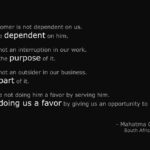This article first appeared in Management Magazine September 2014- a Publication of Kenya Institute of Management
Management and service experts alike have for a long time believed that customers define brands. But things have changed. According to Shep Hyken, customer service expert, business speaker and New York Times bestselling author “Customers may define your band, but employees are your brand.”
Powerful brands are so because they consistently keep their promises to their customers. And very simply put – that’s what customers like – unfailing consistency. That they will beyond any reasonable doubt find the same product they have always found or the same service they have always enjoyed in the same way every time. That’s what customers get emotionally attached to. The UK Intellectual Property Office, charged with keeping custody of brands’ rights, indicates that a brand is much more than a trade name, symbol or identity, but can also be a ‘promise of an experience’ that conveys to consumers a certain assurance as to the nature of the product or service they will receive and also the standards the supplier or manufacturer seeks to maintain.
The common thread running throughout all these definitions and statements revolving around brands is that consistency and maintaining standards is the name of the game; service excellence consistency and service excellence standards – and there’s no doubt about that. It therefore follows that the all-important question to be answered is – What would it take towards purposefully and intentionally creating a winning brand on service excellence, that would have an organization’s name associated with the value its customers derive from it consistently?
Formidable brands are created by people.
Brand promise delivery is through excellent customer service. A promise is made and customers’ expectations are raised, that the particular product or service will deliver on this promise. What’s relevant to a customer isn’t what the organization values about its products or services, but what the product or service can do to solve the customer’s problems. Understanding customer needs, anticipating their objections and exceeding their expectations are the key tenets around which exceptional service excellence revolves. Dynamic brands that have latched onto this formula think about their customers as the center of their focus and rally their product development and service enhancement teams around delivering first class experience. Many an organization has succumbed to the folly of reflecting inwards to provide to customers outputs based on what they think the customer wants or needs to know, rather than packaging their givings as winning ‘solutions’
· Emotional decision making
“What people want is the extra, the emotional bonus they get when they buy something they love” This quote by Seth Godin – author, entrepreneur, marketer, and public speaker points directly at the irrational thoughts that make brands what they are. Warm feelings towards brands are created by; the people that deliver the brand promise; actualization of the brand messaging that promises to provide the customer the solution for which the brand was created; and interaction with the values that the faces and hearts behind the brands epitomize. Winning brands get that way by decidedly worming and working their way into the hearts of their customers. They aim for the effect that when the brand name is mentioned, it evokes a feeling of friendship, warmth, value and partnership. The 2013 research ‘From Promotion to Emotion’ by The Corporate Executive Board Company reveals that despite our(customers) attempts to make purely rational decisions, we are primarily driven by emotional motivations. Dynamic brands have tapped into servicing these emotional needs with excellence.
· Customer centric processes and systems
A brand’s continuous improvement is dependent on customer feedback that directly feeds into innovation and dynamic structuring and restructuring of business procedures, policies and practices. Listening to the voice of the customer (VOC) and using the inputs to tweak operations is the secret ingredient to successfully delivering service that wows the recipient. Wow service produces great brands.
Apple-Apple Inc. – the world’s most valuable brand in the Omnicom Group’s “Best Global Brands” 2013 report declare “We are at our best when we deliver enriching experiences. What we tell our staff: Approach customers with a personalized, warm welcome: Make sure customers are greeted by a friendly smile, Probe politely to understand the customer’s needs (ask closed and open-ended questions), Present a solution for the customer to take home today, Listen for and resolve any issues or concerns: By truly listening and acknowledging the needs of your customers, you make your business an oasis of encouragement, empowerment, and excitement. End with a fond farewell and an invitation to return: There is a direct correlation between how people feel when they leave your business and how likely they are to return or recommend the experience to someone else.”
Tucked into this philosophy is a clear customer focused system to listen, understand and act accordingly. The process for handling customers has clearly been outlined to staff who know the what, where, how, when and why enriching experiences need to be created. Walking in the customer’s shoes spurs system audits to observe the customer experience whilst interacting with the organization. If customer excellence temperatures are measured at each customer touch point in the customer journey as they engage with the brand, it is inevitable that enhancements will be made to optimise the experience.
Tied closely to this is the emphasis that international quality management systems place on the customer. The most popularly implemented 1SO 900:2008 Quality Management System has an entire chapter clause 5:2 dedicated to focusing the organization’s quality processes towards serving customer needs.
“Quality is never an accident, it is always the result of high intention, sincere effort, intelligent direction and skillful execution; it represents the wise choice of many alternatives”. William A. Foster








